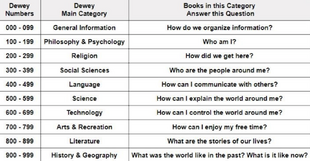
An overview of the DDC's main classes.
The Dewey Decimal System, also known as the Dewey Decimal Classification (DDC), is a real-life library classification system that the Hotel Denouement uses to organize itself. Dewey Denouement is presumably named after it.[1] In the hotel, every room is numbered with the Dewey Decimal System, and a given room's inhabitants reflect that classification. For example, room 469 (Portuguese) housed Portuguese guests. Each room had a bell in the lobby which would ring when a guest needed assistance.
The system is used in many real-life libraries as a way to sort non-fiction media in the stacks. It is primarily employed by public libraries and similar systems; academic libraries more commonly use systems similar to the Library of Congress Classification System. Counterintuitively, most of the libraries depicted in A Series of Unfortunate Events are either private libraries (like Justice Strauss' library) or academic/research libraries (like the Library of Records at Heimlich Hospital), not public libraries. The DDC was likely chosen for its popularity and simplicity.
Function[]
In the system, non-fiction media is assigned a number from 000.01 through 999.99, depending on the subject matter it covers. The ten main classes (000, 100, 200, ... 900) cover the broadest areas, like 'General Information' (000) and 'Pure Science' (500). Each of these ten classes is then divided into ten more classes represented by the tens place (010, 020, ... 550, 560, etc.) which offer more specific information. For instance, class 400 (Language) includes the subclasses 410 (Linguistics), 430 (German & Related Languages), and 490 (Other Languages), among others. Each of these 100 subclasses is then subdivided further into the ones place (001, 002, ... 583, 584, etc.) which focus on a very specific aspect of a given study. For example, the class 600 (Technology) includes the subclass 670 (Manufacturing) and the number 674 (Lumber processing, wood products, and cork). The class 300 (Social Sciences) includes the subclass 360 (Social Problems and Social Services) and the number 366 (Secret Associations and Societies). After the ones place, classifications are divided into the 10ths (.1) and 100ths (.01) places, and then by the first letters of the author's last name.
Trivia[]
- In real life, the system was first published in 1876 by Melvil Dewey, who was also a librarian. It was originally a four-page pamphlet, but had since expanded into a variety of volumes and revised 23 times. The latest edition was published in 2011.
